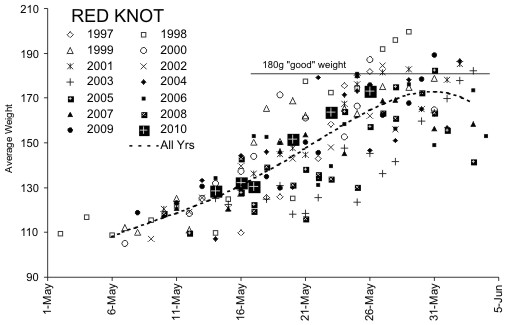It’s even more difficult to keep up with a blog with so much happening at once.
On Tuesday (May 25th) we spent much of the afternoon trying to catch a red knot with a geolocator we attached last year. We managed it, our fourth, and while making the attempt we saw in the distance over the bay a single flight of red knots. The birds formed in a rough v-shape and slowly gained attitude as they headed into the north. As they went out of sight we realized we saw the first flight of fat red knots departing toward their Arctic breeding ground. That evening we watched over a thousand red knots follow in many small flocks.
On Wednesday morning we made a good catch of red knots that showed us why. The average weight of all knots caught had increased dramatically over the last few days approaching the critical level of 180 grams — the weight needed to successfully reach the Arctic and breed.

The graph above shows the average weights of red knot catches that we have made since 1997. The ideal weight of 180 grams is the horizontal line. The average for May 2010 catches is a square with a white cross. The birds we saw rushing off to the Arctic will decrease the average weight as will newly-arrived, low-weight birds. Nevertheless, this year’s red knot flock in New Jersey appears to be doing very well. In Wednesday’s catch several birds weighed-in at over 220 grams, nearly one hundred grams higher than average weight three weeks ago.
118 gram and 221 gram knots held by Larry Niles
That evening, Ron Porter brought over the new map of the geolocator bird we caught on Tuesday. We attached the device last year on May 26th . Afterward, the knot left for the Arctic. It ranged widely from Southampton Island to King William Island but likely did not breed. It flew south through James Bay, eventually to the New Jersey Atlantic coast to rebuild it’s condition for 17 days. Then it set off on an epic journey across the Atlantic Ocean to Brazil where it wintered, ultimately returning to the Delaware Bay this spring. The most amazing part is that this knot left Brazil on May 19, flew non-stop, and arrived on the Delaware Bay four days later on May 23! Knowing the flight path of one red knot through the year is a great leap forward in our understanding of the species. These details will transform our efforts to conserve the species. The fact that one knot stopped over on the Atlantic Coast of New Jersey in the fall speaks loudly about the need for shorebird protection in places like Brigantine Natural Area, Stone Harbor Point and North Wildwood.
We completed the aerial and concurrent ground count on the May 26th . The total count red knots was just under 15,000 birds, far lower than the estimated number last year, but close to counts of 2008. Last year’s aerial flight was grounded during the critical period of May 24-28th and relied mostly on ground counts. Although we have another count this week, the 15,000 number is likely to be the highest.
